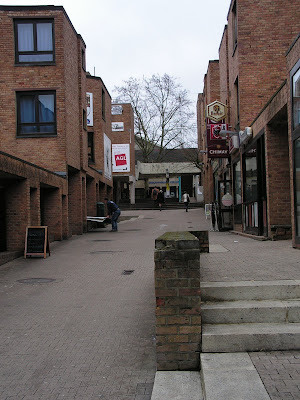Monday, February 28, 2011
If these walls could speak...
The walls do speak in Louvain-la-Neuve, in the murals that are found everywhere. With all this new construction, there are lots of canvases available. It helps break up the monotony of brick, brick, brick. Make no mistake, I like brick, but it's good to have something to relieve the eye.
Labels:
art,
bricks,
Louvain-la-Neuve,
murals
Sunday, February 27, 2011
The seed of truth
All my stories start with a seed of truth. That has been my tagline for many years. It lets me off the hook most often with what I call "personal fiction."
As I was wandering around Louvain-la-Neuve the other day, I thought about a story I wrote that is set here. This is where the seed was planted.
The story is poetically called Blood and is a part of my longer story Blood, Guts, Spies and Fat Naked Ladies, about the year I spent in Bulgaria. Strangely enough, the year in Bulgaria began with the year in Belgium. So confusing, those B-l-g countries...
Anyway, the story begins when I saw a sign for the blood donation center. Here it is:
 Okay, it's not the same building. This building above didn't exist at the time,but I gave blood right across the way from here. I saw signs on the street that said "Don de sang,'' which means "Blood donation." I'd given blood at home often, so I went on up.
Okay, it's not the same building. This building above didn't exist at the time,but I gave blood right across the way from here. I saw signs on the street that said "Don de sang,'' which means "Blood donation." I'd given blood at home often, so I went on up.
I met a cute guy named Pedro at the blood donation center. After I gave blood I was offered a huge sandwich, some schwag, and beer or wine. I declined the alcohol--I had to hurry to my Bulgarian class. When I arrived my professor, Mme Staneva, was shocked that I had done something so risky as to give blood.
Later in the story I met Pedro again and started going out with him. We were sitting outside Café Grand' Place one day, having a drink when Mme Staneva went by. I introduced them.
Parts of the story actually happened, parts did not. The seed of truth was that I gave blood and my professor was appalled. She said, in her strong Bulgarian accent, "Priscilla, you must not to give blood. Is very dangerous thing to give blood. You promise me you never to give blood again." I did meet a guy named Pedro, and we did go out. I also spent a huge amount of time at that café.
I love the process of finding a story. I knew that I wanted to tell a story that included Pedro and dancing. Then one day I told my brother-in-law the anecdote about giving blood. He laughed just the right laugh, the one that indicated that there was a real story in there. I remembered that Pedro's hair came to a widow's peak. I also remembered that Mme Staneva chastised me the next time I gave blood. When I visited her the next summer in Bulgaria, she told her neighbor that I had given blood. Twice!
I muddled around with that for a while, thinking about the importance of blood in Bulgaria, where there are plenty of vampires in folklore. I went looking for a folktale. Aaah, perfect. How to chunk it in? Oh, right, have Mme Staneva tell it to me as a cautionary tale. Finish up the story with Pedro at the end.
I worked on that story with a class of middle school kids. They gave suggestions. I paid close attention to the parts of the story that worked. Where did they laugh? Where did they look confused? Was there anything extraneous that needed to be cut? Of course there was, there always is. A big part of story creation is paring away the unnecessary bits. Finally it felt ready. Done? No, stories tend to continue evolving. Sometimes the best they can be is ready.
I tell that story a few times a year. It's nice to be here in Belgium, where the seed was planted.
Friday, February 25, 2011
Louvain-la-Neuve
Thirty years ago (yikes!) I was a student at the Université Catholique de Louvain, in Louvain-la-Neuve, for my junior year of university. That is when I first met my friend Marie, with whom I stay when I visit Belgium.  I knew Marie from Russian class, but only slightly. She became my real friend two years later when we both lived in Sofia, Bulgaria. Department of Small World. We've been good friends ever since.
I knew Marie from Russian class, but only slightly. She became my real friend two years later when we both lived in Sofia, Bulgaria. Department of Small World. We've been good friends ever since.
At any rate, today I wandered around LLN. Without going into great detail, here's a short history: in the 1960s, there were linguistic differences between the French and Flemish, so the Catholic University of Louvain split in two. The Flemish stayed in the old city of Leuven, with the Katholieke Universiteit Leuven and the French began to build a city for the Université Catholique de Louvain in the middle of some fields. It was designed as a pedestrian city, with parking garages and streets below the buildings, though now there are quite a few cars up above. More than there were 30 years ago, at any rate.
At any rate, today I wandered around LLN. Without going into great detail, here's a short history: in the 1960s, there were linguistic differences between the French and Flemish, so the Catholic University of Louvain split in two. The Flemish stayed in the old city of Leuven, with the Katholieke Universiteit Leuven and the French began to build a city for the Université Catholique de Louvain in the middle of some fields. It was designed as a pedestrian city, with parking garages and streets below the buildings, though now there are quite a few cars up above. More than there were 30 years ago, at any rate.
It's strange that this university, founded in 1425 and boasting such luminaries as Erasmus and Mercator, should look so modern. There's constant building, too.
Here is the iconic picture of the Grand' Place.
When I first arrived, I lived in a dorm room in this building:
It was a large dorm where I didn't know anybody (not for lack of trying). I shared a bathroom with a woman who ignored me completely and had frequent loud parties. Here's Rue des Wallons, not far from the dorm.
Soon after, I moved across town to this place, which I shared with six Belgian students: It was much friendlier, and the building had just been built so it was clean. I learned a lot of French from living with these young women. They became my friends.
It was much friendlier, and the building had just been built so it was clean. I learned a lot of French from living with these young women. They became my friends.
It was a large dorm where I didn't know anybody (not for lack of trying). I shared a bathroom with a woman who ignored me completely and had frequent loud parties. Here's Rue des Wallons, not far from the dorm.
Soon after, I moved across town to this place, which I shared with six Belgian students:
Monday, February 21, 2011
Belgian Tour 2011
I'm back in Belgium, for the tour I make every two years. I arrived on Saturday. Today I was at Collège Saint-Louis in Liège. I left Louvain-la-Neuve this morning at 7:30 by train. Around 9 the train pulled in to the new Liège-Guillemins train station. Last time I was in this city, some years ago, this didn't exist! It was designed by Santiago Calatrava and is quite impressive.
I walked from the train station about 25 minutes to the school, crossing the Meuse river:
 In Belgian cities, it's common to see a mixture of very old and very new architecture.
In Belgian cities, it's common to see a mixture of very old and very new architecture.
Quite near the school is the brand new Médiacité. It's a confusing name, because in fact it's a large shopping mall and entertainment center, not just for media. You can see a little bit of it between these buildings, the red and white structure that looks a bit like a bouncy house. This is where I went for lunch in between shows.
 On to the school. I really enjoyed myself, both with the students and with the teachers, who welcomed me warmly.
On to the school. I really enjoyed myself, both with the students and with the teachers, who welcomed me warmly.
Collège Saint-Louis has an English immersion program, in which students study for part of each day in English. I had two performances, one with the immersion students in 2nd year and one with the students in 3rd year. I think, though I'm not certain, that these are the equivalent of 7th and 8th grades in the US (12-14 year-olds). Because some English immersion schools are for younger children and because I forgot to ask who the audience would be (note to self: ask all the pertinent questions!), I took my puppets. I did what I normally do: I asked these adolescents if they'd like to meet the puppets I have for the younger kids. As usual, they said yes.
The students today were excellent listeners. With adolescents I often start with a creepy story, so the listeners understand that this is not for babies. Today I told the old English story Mr Fox (not an actual fox, but a sly man), a version of Bluebeard. Then on to other stories. I had more time with the first group, so we had a longer Q & A period at the end.
Labels:
Belgium,
English immersion,
Liege,
storytelling
Tuesday, February 15, 2011
Update on the Kansas Arts Commission
According to the Topeka Capital-Journal today, "A bipartisan majority of the House budget committee rejected Gov. Sam Brownback's plan to dissolve the Kansas Arts Commission." It ain't over 'til the fat lady sings, but I'm encouraged.
Saturday, February 12, 2011
P.S. on the arts in Kansas
If you live in Kansas, please consider writing an e-mail or calling your representatives about overturning the Governor's Executive Order #39 eliminating the Kansas Arts Commission. Don't know who your representatives are? You can find them easily on the KU Institute for Policy and Social Research.
Labels:
arts funding,
Kansas Arts Commission
Thursday, February 10, 2011
The arts in Kansas
I'm pretty sure I've told stories to some of these kids. They sent this clip to The Maddow Blog to show that Kansas kids do value the arts.
I should be in Topeka right now, at the rally to support the Kansas Arts Commission. Our new governor has issued an executive order to eliminate the KAC. It will be gone by July 1 unless the legislature overturns the order.
If this order stands, small communities around the state will lose out. Let me be specific: tomorrow I'm going to three schools in Wakefield and Clay Center under the aegis of the Kansas Arts Commission. Wakefield has a population of 898, Clay Center has 4366. The KAC has provided a percentage of my fee and the Clay Center Arts Council has raised the rest locally. When I wrote the contract, I included the phrase, "contingent upon grant funding." If the arts council didn't write these grants, they might not afford artist visits in the schools. Not all of my work is underwritten by the KAC, but when it is, I am aware that the community I'm visiting values the arts.
I'm not at the rally because I woke with a full-blown cold. It has been coming on for days, but I hoped I could bundle up and march. Tomorrow I have three shows at schools in Clay Center, KS though, so I had to weigh short term and long term goals. Short term: be able to perform tomorrow. Long term: help save the KAC, which is funding a portion of my performances tomorrow.
Governor Brownback's action is ostensibly about money, about saving the Kansas taxpayers that .29 per capita the state spends on the arts. It completely ignores the matching funds from sources outside the state that will be lost (cutting $575,000 of the KAC budget jeopardizes $778,200 in federal funds).
If this order stands, small communities around the state will lose out. Let me be specific: tomorrow I'm going to three schools in Wakefield and Clay Center under the aegis of the Kansas Arts Commission. Wakefield has a population of 898, Clay Center has 4366. The KAC has provided a percentage of my fee and the Clay Center Arts Council has raised the rest locally. When I wrote the contract, I included the phrase, "contingent upon grant funding." If the arts council didn't write these grants, they might not afford artist visits in the schools. Not all of my work is underwritten by the KAC, but when it is, I am aware that the community I'm visiting values the arts.
So why support the arts? We need citizens to be creative thinkers, savvy problem solvers, effective communicators. The stories I tell subtly teach moral and ethical lessons. The arts teach about the wider world, in ways that cannot be tested with a No. 2 pencil. Kids develop their emotional intelligence through the arts.
The governor wants to make the KAC into a nonprofit organization, funded privately. This completely ignores the fact that many local private donors have already given and given and given. They're tapped out. And some of us are highly suspicious of the board Brownback has appointed already to this Kansas Arts Foundation--he has a strong right-wing agenda, with support from the Koch brothers. Who will determine what art is "appropriate" in this nonprofit organization?
That's a disturbing aspect of this executive order that is not being mentioned: it's not about the money. Here's what Arlene Goldbard wrote on her blog Life Implicates Art:
That's a disturbing aspect of this executive order that is not being mentioned: it's not about the money. Here's what Arlene Goldbard wrote on her blog Life Implicates Art:
In truth, when politicians decide to decapitate arts funding, they aren’t even trying to make a significant economic impact. Instead, they are using budget cuts as a form of political speech by cutting something that most voters don’t perceive as directly affecting them or creating widespread pain. That is because, even though the dollars involved are insignificant enough to be dismissed as a rounding error in other budget areas, the cuts garner plenty of publicity: artists and their advocates are very good at communicating their displeasure. In essence, politicians use arts advocates as a megaphone to issue a political message: Look at the criticism I’m willing to take to save voters money! I lopped the head off all this unnecessary crap like art before even trimming the fat from the things you really care about! Money is the sizzle, not the steak.I recommend her entire blog post. Later she says,
The most important policy question is this: Who are we as a people? How do we want history to remember us? What legacy do we wish to leave the next generation: our stupendous ability to punish, or our vast creativity? [Earlier, she noted that we have the highest incarceration rate in the world.]Who do we want to be? That's a huge question. I want us to have all the opportunities to be the vibrant, creative, thoughtful, emotionally aware beings we could be. The arts can go a long way toward this. And in the process, why not make Kansas into a place people want to move to or visit, because the people here have those qualities.
Wednesday, February 02, 2011
Blizzard of Oz
That's what they're calling the storm we had yesterday and the day before. I've also heard "Snowmaggedon." They closed down the interstate highway all the way across Missouri because of whiteout conditions. It was incredibly windy, cold and snowy all at once. I stayed inside, with a cat lapwarmer.
 There also wasn't a sidewalk or a set of steps down to the street. We had around 12 inches (about 30 cm) of snow. Not much for some parts of the country--that's what I found on my rental car last Thursday morning in Massachusetts--but a lot for here. As I write this I can hear a car spinning its wheels in the effort to get up the hill. As most have done all day, it will have to slide backwards to the bottom of the hill and try another way.
There also wasn't a sidewalk or a set of steps down to the street. We had around 12 inches (about 30 cm) of snow. Not much for some parts of the country--that's what I found on my rental car last Thursday morning in Massachusetts--but a lot for here. As I write this I can hear a car spinning its wheels in the effort to get up the hill. As most have done all day, it will have to slide backwards to the bottom of the hill and try another way.
This morning I went out to see if there was a newspaper. Nope.
Labels:
2011,
blizzard,
Kansas City,
snow
Subscribe to:
Posts (Atom)







